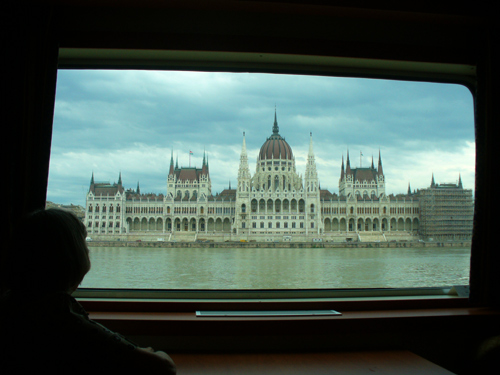 The next morning we docked in Budapest and this was the view of the Parliament building from our cabin.
The next morning we docked in Budapest and this was the view of the Parliament building from our cabin.
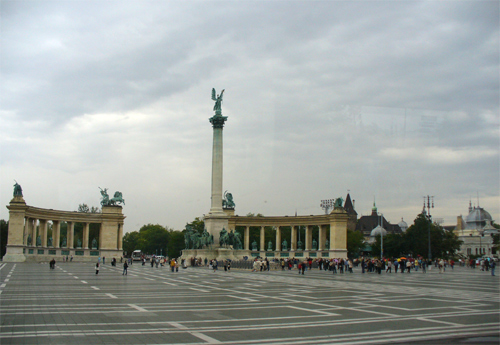 Our tour of the city first brought us to Heroes' Square which was built in 1896 to celebrate the Millenium of the the existence of Hungary. At the center is a 120 foot high column with the angel Gabriel bearing the Holy Crown that is said to have been offered King Stephen I (István in Hungarian) in a dream. Note also the cross, since Stephen was a convert to Christianity.
Our tour of the city first brought us to Heroes' Square which was built in 1896 to celebrate the Millenium of the the existence of Hungary. At the center is a 120 foot high column with the angel Gabriel bearing the Holy Crown that is said to have been offered King Stephen I (István in Hungarian) in a dream. Note also the cross, since Stephen was a convert to Christianity.
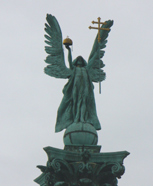
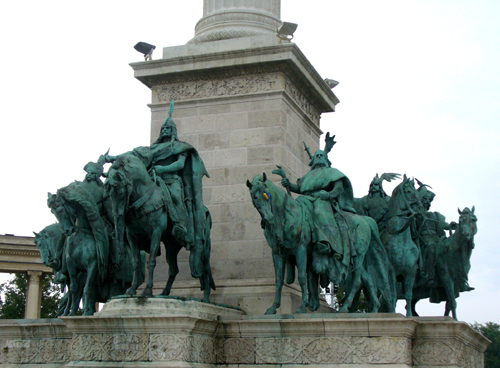 Around the base are menacing Magyar tribal chieftans.
Around the base are menacing Magyar tribal chieftans.
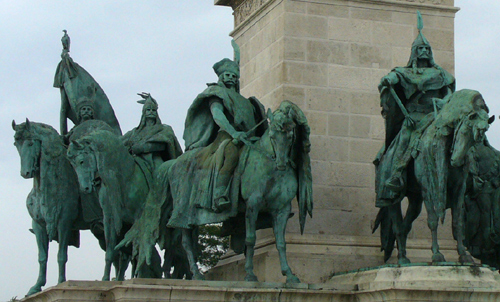 A closer look at these chieftans.
A closer look at these chieftans.
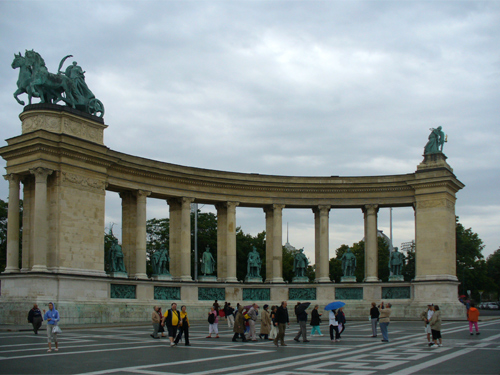 The monument is framed by a pair of colonnades bearing statues of the country's leaders, from Stephen to a man who headed the 1848 revolution.
The monument is framed by a pair of colonnades bearing statues of the country's leaders, from Stephen to a man who headed the 1848 revolution.
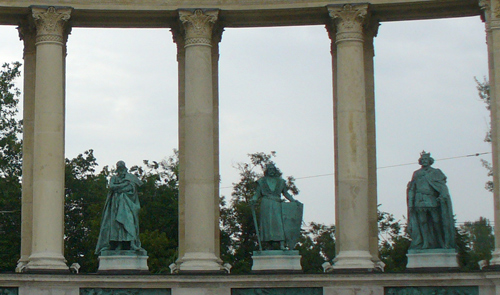
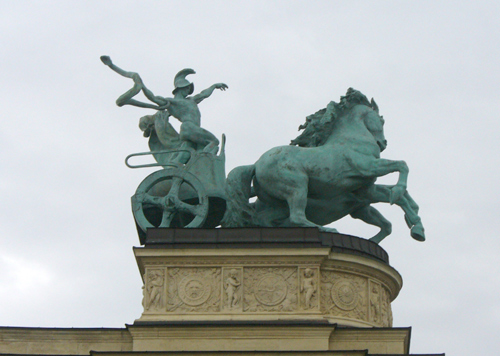 The figures charging above these colonnades are allegories of work and welfare, war and peace and art and science.
The figures charging above these colonnades are allegories of work and welfare, war and peace and art and science.
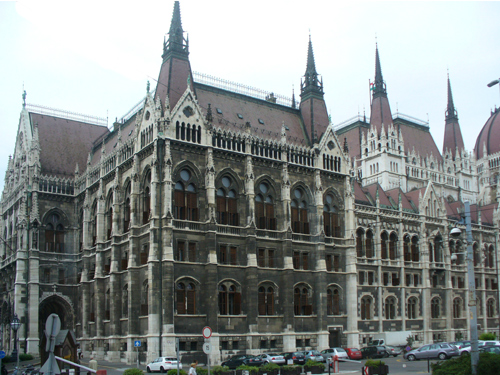 Our tour took us around the Parliament building.
Our tour took us around the Parliament building.
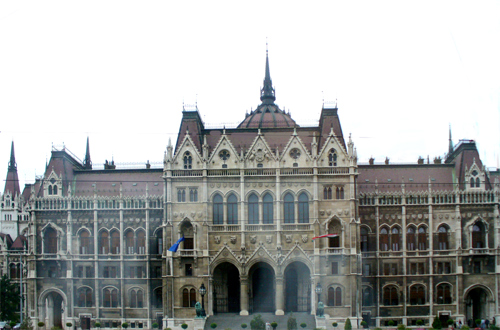 I
I
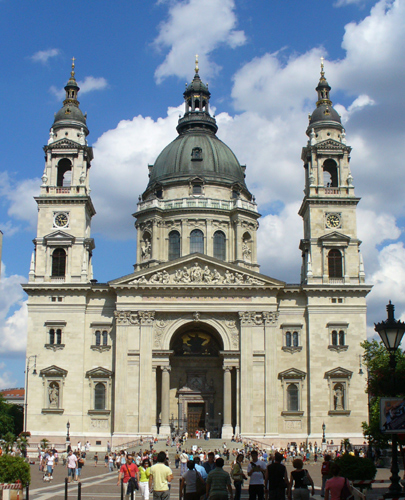 Next we saw the magnificent Roman Catholic Basilica of St. Stephen. (Photo taken the next day.) Along with the Hungarian Parliament Building, it is the tallest building of Budapest (96 m. or 314 feet). It has a width of 183 feet, and its length is 285 feet. It was completed in 1905 after 54 years of construction. Much of this delay can be attributed to the collapse of the dome in 1868 which required complete demolition of the completed works and rebuilding from the ground up.
Next we saw the magnificent Roman Catholic Basilica of St. Stephen. (Photo taken the next day.) Along with the Hungarian Parliament Building, it is the tallest building of Budapest (96 m. or 314 feet). It has a width of 183 feet, and its length is 285 feet. It was completed in 1905 after 54 years of construction. Much of this delay can be attributed to the collapse of the dome in 1868 which required complete demolition of the completed works and rebuilding from the ground up.
The architectural style is neoclassical and the interior is laid out in the form of a Greek cross.
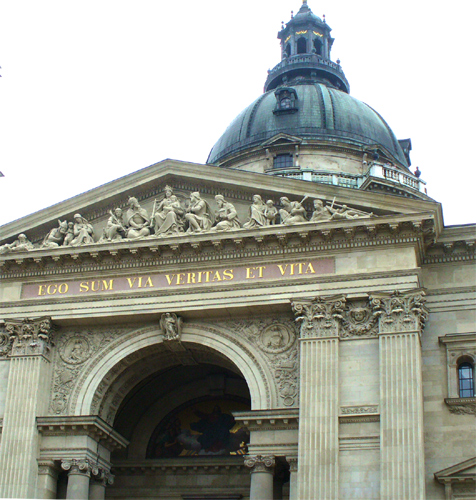 The facade with the statement "Ego Sum Via Veritas Et Vita", which in English is Christ's statement "I am the way, the truth, and the life."
The facade with the statement "Ego Sum Via Veritas Et Vita", which in English is Christ's statement "I am the way, the truth, and the life."
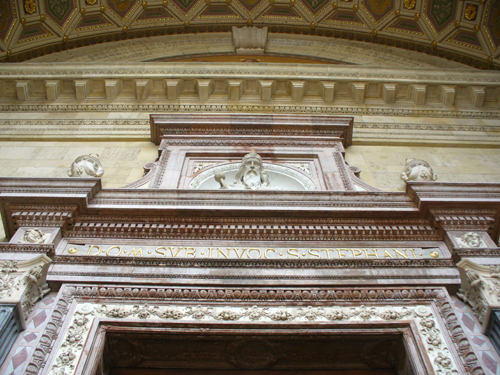 St. Stephen looking down at those who enter.
St. Stephen looking down at those who enter.
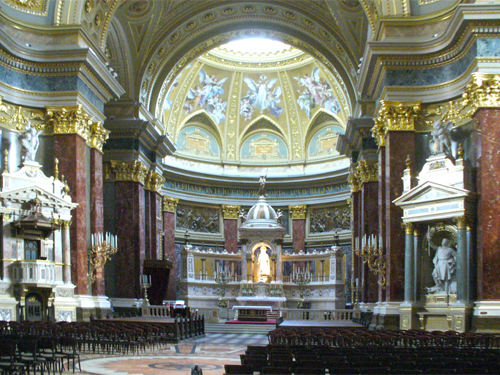 The interior has contrasts, dark and light, black and white, sturdy architecture and delicate art. The Christian story is presented in the context of Hungary's history, using St. Stephen as a focus.
The interior has contrasts, dark and light, black and white, sturdy architecture and delicate art. The Christian story is presented in the context of Hungary's history, using St. Stephen as a focus.
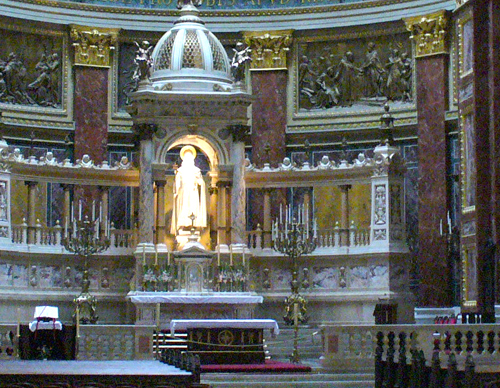 The main altar has a statue of St. Stephen and the bronze reliefs of the chancel illustrate scenes from his life
The main altar has a statue of St. Stephen and the bronze reliefs of the chancel illustrate scenes from his life
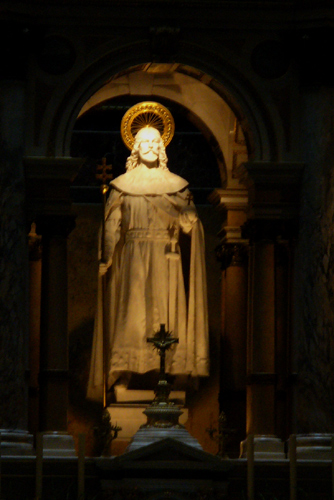 St. Stephen's statue on the main altar.
St. Stephen's statue on the main altar.
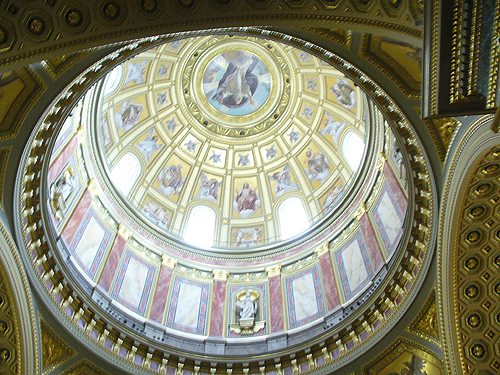 The dome.
The dome.
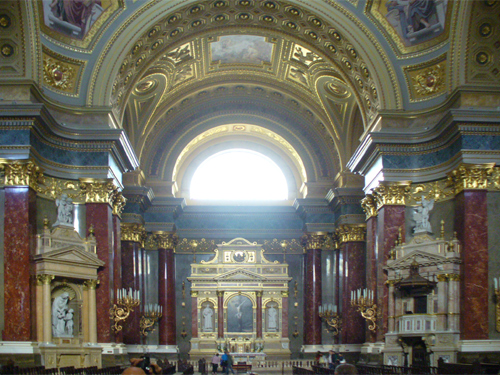 A chapel.
A chapel.
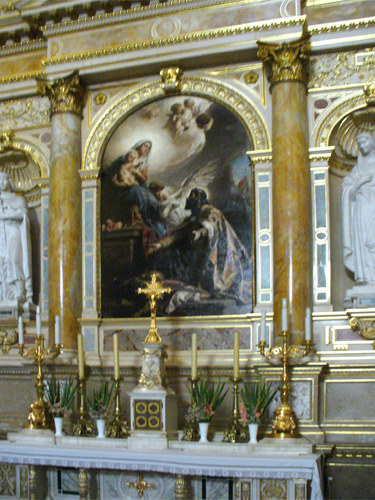 Stephen offering his crown to Mary on the death of his only son.
Stephen offering his crown to Mary on the death of his only son.
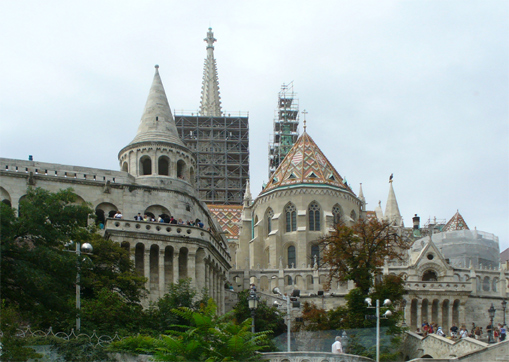 We then crossed the Danube on our way to Castle Hill. We could look up to the Matthias Church and the Fishermen's Bastion where we would soon be.
We then crossed the Danube on our way to Castle Hill. We could look up to the Matthias Church and the Fishermen's Bastion where we would soon be.
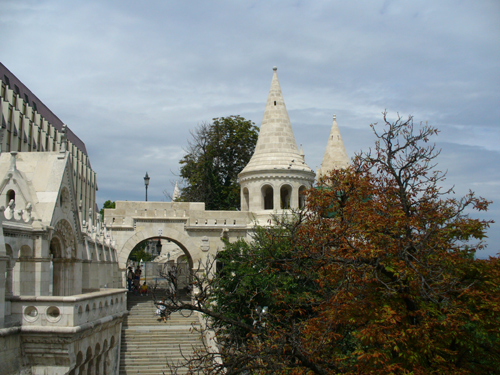 We were soon there to see the towers of the Fishermen's Bastion near the church. According to tradition, this area housed a local fish market during medieval times, hence the name of the Bastion. During the 18th century, the Guild of Fishermen are also said to have traditionally defended this part of the castle wall.
We were soon there to see the towers of the Fishermen's Bastion near the church. According to tradition, this area housed a local fish market during medieval times, hence the name of the Bastion. During the 18th century, the Guild of Fishermen are also said to have traditionally defended this part of the castle wall.
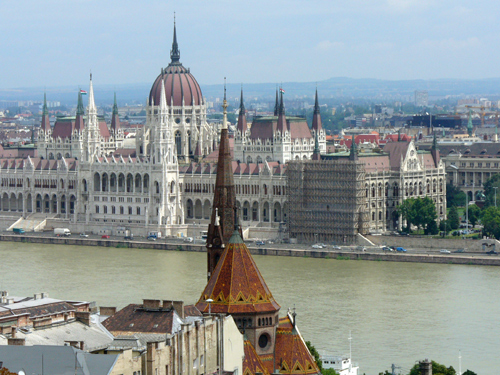 From there we had beautiful views of the city across the Danube.
From there we had beautiful views of the city across the Danube.
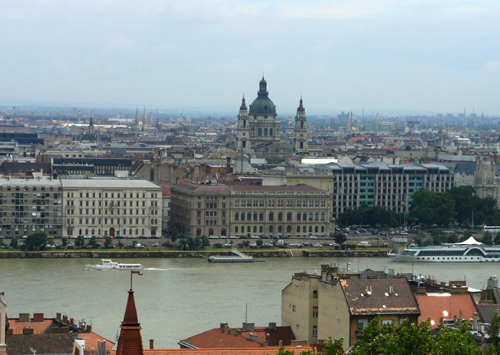 The Basilica of St. Stephen in the distance.
The Basilica of St. Stephen in the distance.
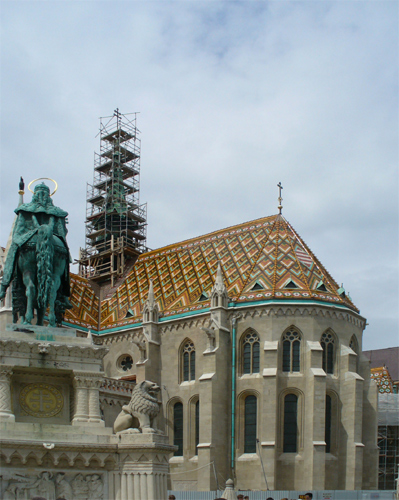 The rear of the Matthias Church with an equestrian statue of King Stephan. Officially called the Church of Our Lady, the church is named after
the main donor King Matthias, who was married here twice. This
symbol of the city was built in the 13th-15th c. in Gothic style.
When the Turks occupied Buda in 1541, it was turned into a
mosque and the frescoes whitewashed. After the retaking of
Buda, it went to the Jesuits, who made Baroque alterations.
It became a parish church after 1773 and was restored in the second half
of the 19th c. and rebuilt in neo-Gothic style.
The rear of the Matthias Church with an equestrian statue of King Stephan. Officially called the Church of Our Lady, the church is named after
the main donor King Matthias, who was married here twice. This
symbol of the city was built in the 13th-15th c. in Gothic style.
When the Turks occupied Buda in 1541, it was turned into a
mosque and the frescoes whitewashed. After the retaking of
Buda, it went to the Jesuits, who made Baroque alterations.
It became a parish church after 1773 and was restored in the second half
of the 19th c. and rebuilt in neo-Gothic style.
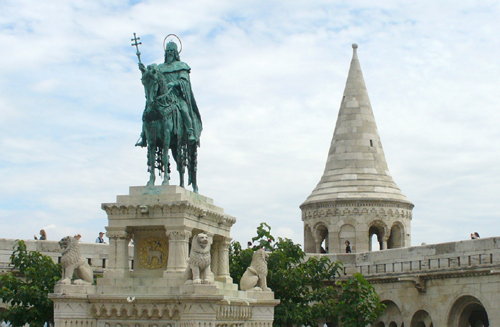 Another view of the statue of King Stephen with one of the conical towers of the Fishermen's Bastion. These conical towers symbolize the naomadic Magyar tribes.
Another view of the statue of King Stephen with one of the conical towers of the Fishermen's Bastion. These conical towers symbolize the naomadic Magyar tribes.
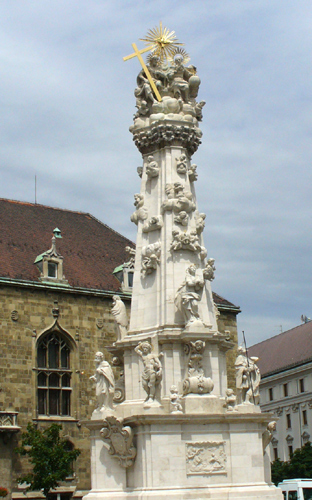 Nearby was this monument to the Holy Trinity.
Nearby was this monument to the Holy Trinity.
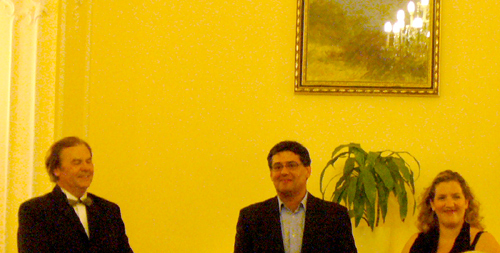 After a short rest, some of us attended a concert, where the soloists sang arias from some favorite operas as well as some songs from operettas. We also had dinner in this building near the St. Stephen's Basilica.
After a short rest, some of us attended a concert, where the soloists sang arias from some favorite operas as well as some songs from operettas. We also had dinner in this building near the St. Stephen's Basilica.
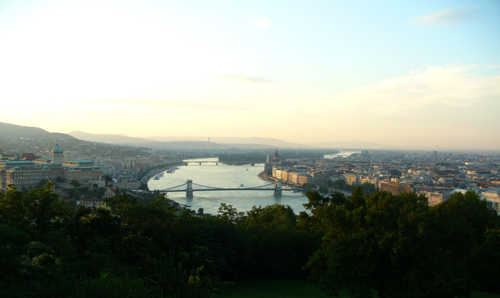 After dinner, our bus took us up Gellert Hill for a wonderful view of the Danube and the city at sunset
After dinner, our bus took us up Gellert Hill for a wonderful view of the Danube and the city at sunset
Earlier in the day, Elizabeth and I had found some of the Roman ruins of Aquincum.
Tomorrow some of us will go to Szentendre" while we and others spent more time in Budapest.
